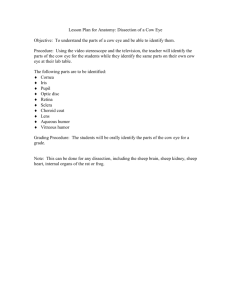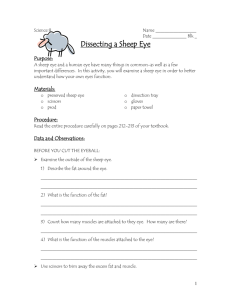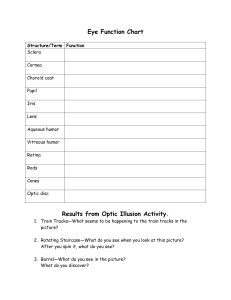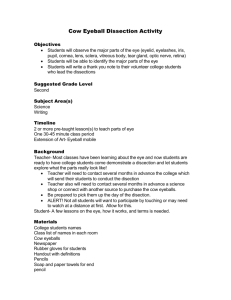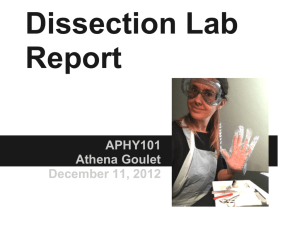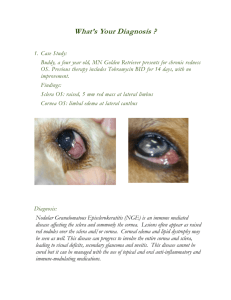sheep eye dissection procedures
advertisement
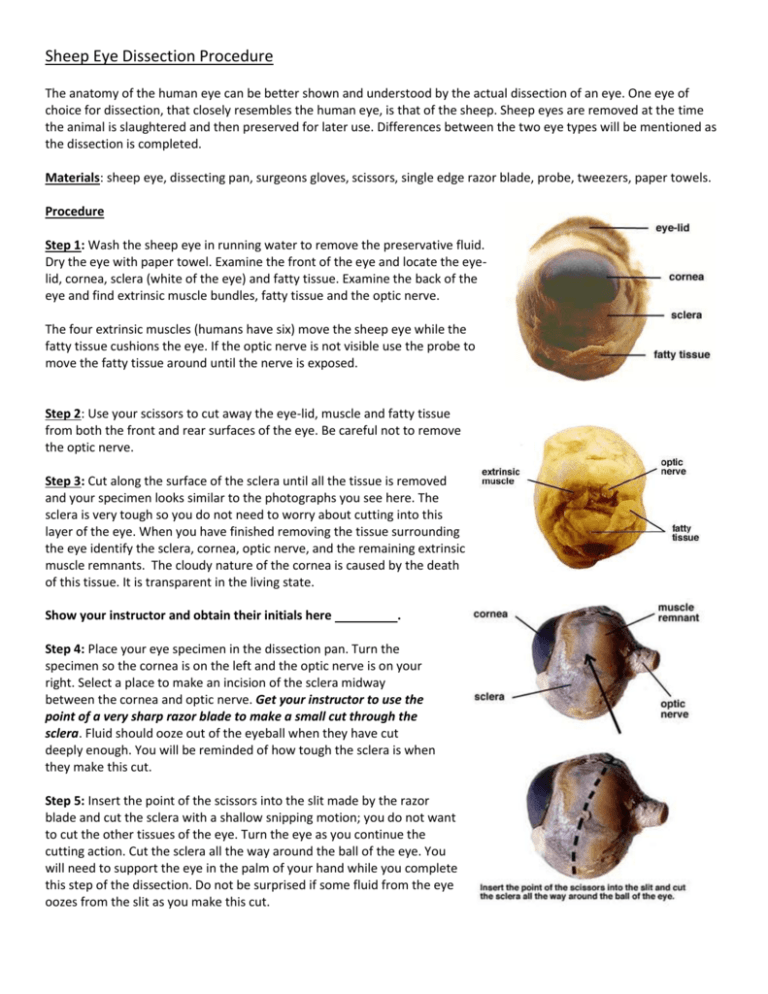
Sheep Eye Dissection Procedure The anatomy of the human eye can be better shown and understood by the actual dissection of an eye. One eye of choice for dissection, that closely resembles the human eye, is that of the sheep. Sheep eyes are removed at the time the animal is slaughtered and then preserved for later use. Differences between the two eye types will be mentioned as the dissection is completed. Materials: sheep eye, dissecting pan, surgeons gloves, scissors, single edge razor blade, probe, tweezers, paper towels. Procedure Step 1: Wash the sheep eye in running water to remove the preservative fluid. Dry the eye with paper towel. Examine the front of the eye and locate the eyelid, cornea, sclera (white of the eye) and fatty tissue. Examine the back of the eye and find extrinsic muscle bundles, fatty tissue and the optic nerve. The four extrinsic muscles (humans have six) move the sheep eye while the fatty tissue cushions the eye. If the optic nerve is not visible use the probe to move the fatty tissue around until the nerve is exposed. Step 2: Use your scissors to cut away the eye-lid, muscle and fatty tissue from both the front and rear surfaces of the eye. Be careful not to remove the optic nerve. Step 3: Cut along the surface of the sclera until all the tissue is removed and your specimen looks similar to the photographs you see here. The sclera is very tough so you do not need to worry about cutting into this layer of the eye. When you have finished removing the tissue surrounding the eye identify the sclera, cornea, optic nerve, and the remaining extrinsic muscle remnants. The cloudy nature of the cornea is caused by the death of this tissue. It is transparent in the living state. Show your instructor and obtain their initials here . Step 4: Place your eye specimen in the dissection pan. Turn the specimen so the cornea is on the left and the optic nerve is on your right. Select a place to make an incision of the sclera midway between the cornea and optic nerve. Get your instructor to use the point of a very sharp razor blade to make a small cut through the sclera. Fluid should ooze out of the eyeball when they have cut deeply enough. You will be reminded of how tough the sclera is when they make this cut. Step 5: Insert the point of the scissors into the slit made by the razor blade and cut the sclera with a shallow snipping motion; you do not want to cut the other tissues of the eye. Turn the eye as you continue the cutting action. Cut the sclera all the way around the ball of the eye. You will need to support the eye in the palm of your hand while you complete this step of the dissection. Do not be surprised if some fluid from the eye oozes from the slit as you make this cut. Step 6: Arrange the two hemispheres of the eye as you see in the above photograph. Observe the jelly-like vitreous humor that fills the centre of the eye. It is transparent in the living eye but might be cloudy in the preserved specimen. The vitreous humor along with the aqueous humor helps to maintain the shape of the eye. Step 7: Take the back piece of the eye. The retina (which contains the rods and cones) lines the back cavity of the eye. Use your probe to lift and pull the retina back from the underlying choroid layer. See the photograph on the right side above. Notice that the retina is only firmly attached to the choroid at one place. This region is the optic disc or blind spot. Here the nerve fibers leave the retina and form the optic nerve which is directly behind the blind spot. Step 8: Take the front part of the eye. Use your tweezers and probe to remove the vitreous humor from the anterior hemisphere of the eye. Try not to disturb the lens that is just below the vitreous humor. Step 9: Removal of the vitreous humor reveals the lens, ciliary body and suspensory ligaments. In the normal condition the lens is transparent. The normal lens is convex shaped and somewhat elastic. It is held in place by the suspensory ligaments that in turn join with the smooth muscle containing ciliary body. Step 10: Remove the lens by pulling it free from its attachments. Note the shape of the lens, its stiffness and opaqueness. Step 11: When the lens is removed, an opening, allowing light to enter the eye is seen. This opening, the pupil is located in the center of the iris. Note the oblong shape of the sheep pupil; in humans the pupil is circular. The back side of the iris can be seen just above the pointer in the photograph. A second cavity or space is present between the iris and the cornea. This space is filled with a second semi-liquid fluid, the aqueous humor. This fluid, like the vitreous humor helps to maintain the shape of the eye. Show your instructor and obtain their initials here . Sheep Eye Dissection Lab Report Focus Question How is the sheep eye similar and different from the human eye? Hypothesis Write a statement that answers the focus question. Materials Make a list of the instruments and equipment that you used in the dissection. Procedure You do not need to write a procedure for this lab since it has already been written for you. Simply refer to it in your lab report and staple it to your report when you hand it in. Observations Make a drawing of the sheep eye in cross section; this is through the middle of the eye looking at the eye from the side. Label the following: Cornea Sclera Retina Lens Optic nerve Vitreous humor Aqeuous humor Discussion 1. The sheep is a mammal just like humans; however human eyes are not quite the same as the sheep eye. Make a conclusion that combines your observations of the sheep eye and the information in the procedure that answers your hypothesis. Include as many differences as possible! 2. Research what the ‘fovea’ is and describe both its structure and function. 3. State 2 differences between the preserved sheep eye and how the eye would be while alive. 4. The sheep eye has a reflective coating on the back of the eye. Research what this is and why sheep have it. 5. Birds rely heavily on their vision. State 3 differences between the avian eye and the mammalian eye in which the avian eye is ‘better’ than the mammalian eye. SNC2D – Sheep Eye Dissection Lab Name Hypothesis Hypothesis – Reasoning Materials Requirements Properly formatted sentence stating clearly the prediction of the results for this lab. Properly stated sentences that give reasons for hypothesis using science and facts learned in class or through independent research. Complete list of equipment and chemicals used. Procedure – Numbered Proper reference to procedure Observations – Diagram Eye diagram is properly detailed Observations – Labels Eye diagram is labeled correctly and neatly (used a ruler) Discussion – A minimum of three differences between the human eye and the sheep eye are stated specifying the characteristics for both The structure and function of the fovea are stated correctly Discussion – Mark I 2 1 0 I 3 2 1 0 C 4 3 2 1 0 C 2 1 0 C 7 6 5 4 3 2 1 0 C 7 6 5 4 3 2 1 0 I 6 5 4 3 2 1 0 I 2 1 0 Discussion – Two differences are stated between the live sheep eye and the preserved sheep eye I 2 1 0 Discussion – The name and function of the reflective coating on the back of the sheep eye is correctly stated I 2 1 0 Discussion – Three differences between the human eye and the avian eye are stated I 3 2 1 0 Notes Total Mark Inquiry /20 Communication /20 Virtual Dissection Lab Report Go to the following website: http://www.youtube.com/watch?v=JWH4CvZz3rY 1. Make the following drawings of the eye. Each drawing must include labels of the structures that can be seen, and a title of the drawing. a. After step 3; a side view of the whole eye once all the fatty tissue and extrinsic muscle have been removed b. After step 6 of both hemispheres of the eye, a top down view of the inside. c. After step 11 of the front hemisphere of the eye, looking at the inside of the pupil, iris and cornea.

